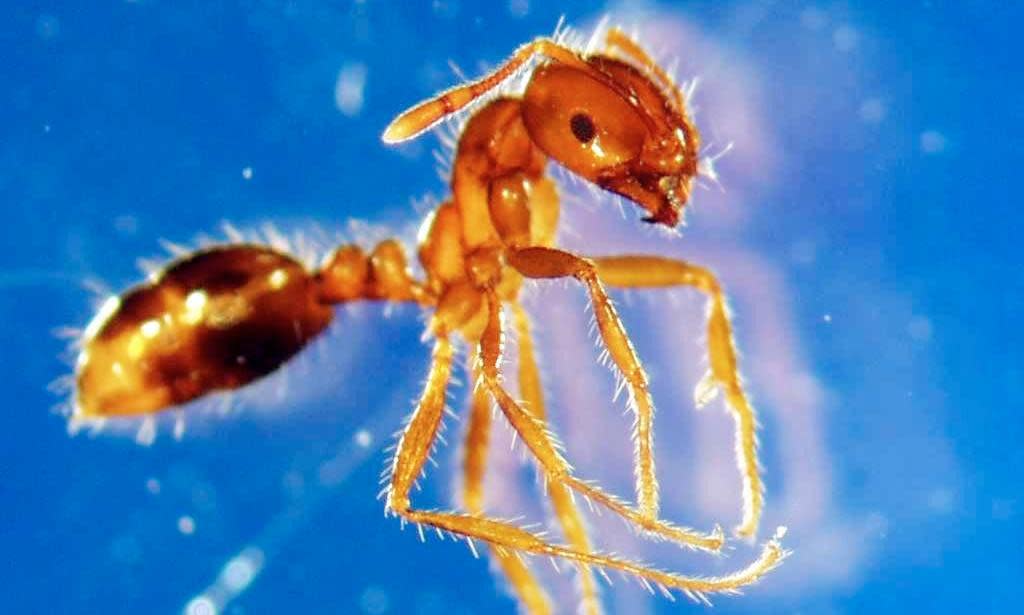Fire ant crackdown: turf from Queensland must be chemically treated when laid in NSW

Turf from fire ant-infested south-eastern Queensland will need to be specially treated when it is laid in New South Wales as part of the crackdown on the spread of the extremely invasive pest.
Under amendments to NSW’s biosecurity (fire ants) emergency order, fines of up to $2.2m can be meted out to those who fail to chemically treat turf that originated in the red imported fire ant (Rifa)-affected zone in Queensland.
Installers in NSW must either treat turf immediately after it is laid, or store it in “preventative conditions” until installation.
The insects can kill people and livestock as well as damage infrastructure and ecosystems and have infested about 700,000 hectares in the Brisbane area.
The move comes after the detection of six Rifa nests in Murwillumbah, 13km south of the state border in November, all of which were genetically linked to the Queensland infestation and were traced to a delivery of turf from the infested zone.
A separate nest was found in Wardell, also in the NSW northern rivers, in January. It too was genetically traced to Queensland and is believed to have been transported to NSW in landscaping products.
The NSW minister for agriculture, Tara Moriarty, said turf had been targeted because it was “a high-risk carrier, providing the perfect environment for ant settlement and movement”.
“Fire ants are not marching into NSW; they are being carried, and it’s this human behaviour we are addressing both through education and compliance measures,” she said on Tuesday.
Related: Millions of Australians at risk of being stung by fire ants each year, experts warn
The changes required applying a chemical that was low in toxicity, safe to humans and animals, low cost, readily available and approved by the Australian Pesticides and Veterinary Medicines Authority, she said.
“By applying this treatment and keeping fire ants out of NSW, the turf industry is contributing to protecting our environment and economy,” she said.
John Keleher, a turf farmer and south-east Queensland turf industry representative based in Canungra, said the latest amendment comes on the heels of another in January that saw all supplies to NSW stop overnight.
Roughly 20% of his business was to NSW customers, he said, including a set of sports ovals in Tweed that were now sitting half laid. Turf farmers were seeking communication and clarity on the rules, which imposed “another layer of costs” to fully Rifa-compliant farmers in the infested zone.
Rifa baits and chemical treatments had become difficult to buy because of a run on the products since the rule changes, he said, and he was concerned about untreated nests he had observed along the “fire ant highway” that runs between the states.
“I’m all about controlling fire ants,” he said. “There have been a lot of funds implemented and we really need to see eradication, but we need to have a unified approach.”
Restrictions are in place on the movements of other fire ant carrier materials including mulch, compost, manure, soil, hay, potted plants, earthmoving equipment, sand and gravel.
Reece Pianta of the Invasive Species Council welcomed the amendment, calling it “a positive change”.
“It’s obviously informed by what’s happened at Murwillumbah and we hope that it becomes a model that can be used on other materials that originate in the fire ant zones,” he said.
Breaching the emergency order can lead to a $1.1m fine for individuals, with a further penalty of $137,500 for each day the offence continues. Businesses can be fined $2.2m plus $275,000 each day thereafter.
All turf from Rifa-affected zones in NSW and Queensland is subject to a record of movement declaration and Queensland-sourced turf must also include a plant health certificate.
Rifa are native to South America and are believed to have arrived via infected materials on ships at the port of Brisbane in 2001, though they may have been in the country since 1992. They are dark reddish-brown with darker abdomens. Their nests look like small mounds of loose, crumbly dirt.
In January Pianta said members of the public should report any suspected sightings of Rifa or Rifa nests to Queensland or NSW hotlines.
“Let’s all be vigilant, let’s see if we can find them,” he said.


